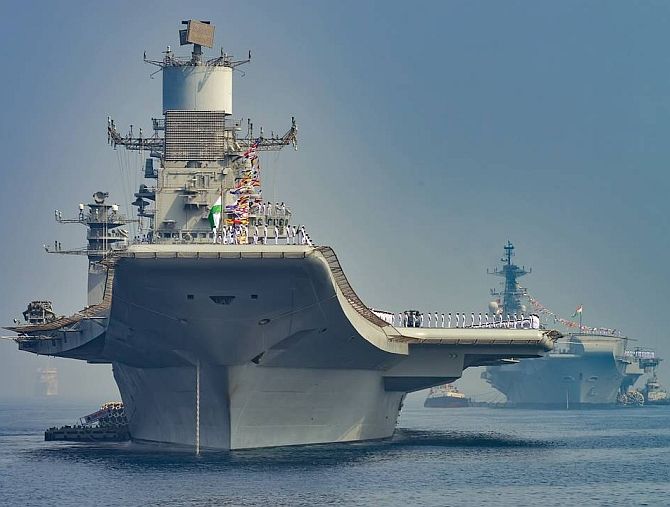Beyond the British and Russian strands interwoven into the Indian Navy's equipment profile and the strong drive towards indigenisation evident today, its future in aircraft carriers appears increasingly linked with America. Ajai Shukla reports.

The navy on March 6 decommissioned Indian Navy Ship Viraat, the world’s oldest aircraft carrier, 58 years after she entered operational service with the Royal Navy in 1959. During this period, she sailed over a million kilometres, enough to circumnavigate the world 27 times.
According to centuries-old naval practice, the decommissioning was formally completed when two flags -- the Viraat's commissioning pennant, and the naval ensign -- were lowered at sunset in Mumbai on March 13, 2017.
Highlighting the nostalgia around the decommissioning, all but one of the carrier's 22 Indian commanding officers attended the ceremony.
As a mark of respect, the Royal Navy's First Sea Lord (navy chief), Admiral Sir Philip Jones, also attended the decommissioning.
The 28,000-tonne aircraft carrier was first commissioned into the United Kingdom's Royal Navy as HMS (Her Majesty’s Ship) Hermes in 1959. The highlight of her 26 years in British service was the Falklands War, when she served as the flagship of the Royal Navy task force in the Southern Atlantic.
Three years after the Falklands War, she was decommissioned in 1985. After two years of refit in Devon Shipyard, she was commissioned as INS Viraat into the Indian Navy, eventually serving another 30 years.
Symbolising a bygone era, INS Viraat was the navy's last British-built warship. The Royal Navy established and trained the modern Indian Navy, which British admirals commanded till April 21, 1958. Up to the 1970s, the UK supplied India’s first modern warships, including its first aircraft carrier, INS Vikrant, and six Leander-class frigates.
In the 1980s began decades of Russian affiliation, when India bought dozens of cheap Russian missile corvettes and its first destroyers, the Rajput class.
As Indian designers began building the first indigenous warships, including the Godavari-class frigates, Russian influence was evident in their design.
Meanwhile, the navy continued buying Russian warships, such as the six Talwar-class frigates and the navy’s current flagship -- INS Vikramaditya (formerly Admiral Gorshkov).
Currently, India is building its next carrier, also named INS Vikrant, at Cochin Shipyard Ltd, Kochi. This 40,000-tonne vessel, which has been delayed by almost a decade, is likely to be commissioned in 2023.
Beyond the British and Russian strands interwoven into the navy's equipment profile and the strong drive towards indigenisation evident today, its future in aircraft carriers appears increasingly linked with America.
The navy has decided that INS Vishal, the 65,000-tonne indigenous aircraft carrier that will follow INS Vikrant, must be a technologically cutting-edge warship with numerous American features.
These include nuclear propulsion and the new US 'electro-magnetic aircraft launch system' that makes it possible to quickly launch different types of combat aircraft that would provide a major combat edge.
Given the US Navy's pre-eminent reputation as the premier operator of carrier borne air power, New Delhi is consulting closely with Washington on designing INS Vishal.
A 'joint working group' that discusses design aspects is amongst the most successful cooperative enterprises between the two militaries.
The navy wants at least 55 aircraft on board INS Vishal, including two squadrons of fighters, electronic warfare aircraft to mask them in combat, airborne early warning aircraft to monitor and control airspace, and helicopters for special operations, anti-submarine warfare and communications duties.
After earlier supporting the indigenous Tejas fighter for its aircraft carriers, and also the Russian MiG-29K/KUB, the navy has now switched to backing the American F/A-18E/F Super Hornet, which Boeing has offered to build in India.
Choosing US carrier-borne fighters would further tighten design and operational cooperation with America.
The future of the decommissioned Viraat remains uncertain. Unless a buyer emerges in the next four months, or the Andhra Pradesh government makes good on its offer to convert it into a floating naval museum, the Viraat will head to the ship-breakers and sold as scrap.
Alternatively, NDTV quotes the navy chief, Admiral Sunil Lanba, as indicating that the warship may be sunk and converted into a divers' destination.












 © 2025
© 2025